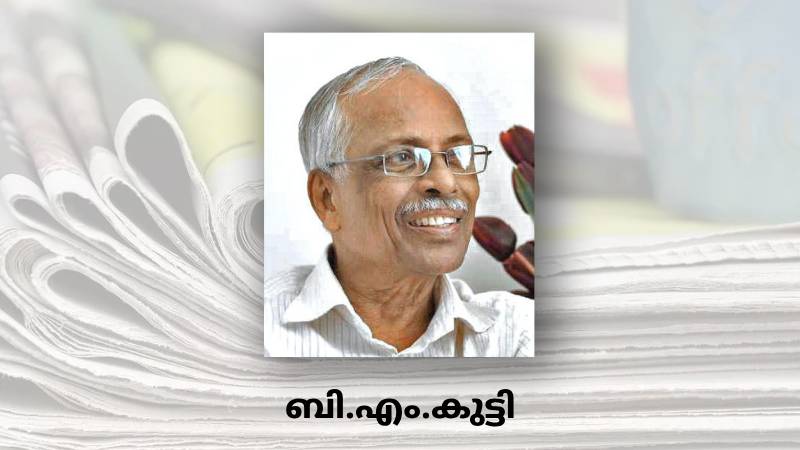Kerala is perhaps the only Indian state where journalism had attained a place of pride even in the sixties. Literacy was high and newspapers were having more printing units and local editions. Many of the present day newspapers in the mainstream were launched in the late 19th and in the early 20th century to fight for India’s freedom from British. They also fought autocracy and social evils. This legacy remains alive.
Late E. M. S. Nambudiripad, a noted political thinker of the state, had observed that history of renaissance in Kerala is actually the history of the press in Kerala. Prof. Robin Jeffrey who has extensively written about Kerala observes that it was literacy and politicalisation, one helping the other, that created the very particular media and also the media influenced society of Kerala.
Kerala’s achievements in social development and quality of life are encouraging. The state has achieved a human development index comparable to the developed countries of the World. The literacy rate is highest of all Indian states. The mass media is also booming. Circulation is growing even when TV news channels are mushrooming. The newspapers enjoy widespread readership and credibility.
But when it comes to watchdog reporting the scene was not encouraging, according to various research studies undertaken by academic institutions and press academy in Kerala. It was not that media in Kerala was not interested in watchdog journalism. But to many people, investigative reporting was just a sensation. Journalists were chasing scoops and there was little focus on a systematic approach about professional discipline of assembling and verifying facts.
The year 1997 marked 150th anniversary of Malayalam journalism. There was much of celebrations in Kerala. It was Herman Gundert, a German missionary who launched the first Malayalam newspaper-Rajaya samacharam in 1847.
There is much difference of opinion on whether the so called first newspaper was really a newspaper, in the modern sense of the term, as the main motto of the publication was religious propaganda that is spreading Christianity. Nevertheless, seminars and discussions were held in 1997 and 1998 about the progress that Malayalam media achieved in the one and a half centuries. One book was brought out by Kerala Press Academy, and another was done by Kesari Memorial Trust under the Kerala Union of working Journalists. Both the books contained lengthy studies on almost all aspects of Malayalam print media.
There was no mention of investigative reporting in those studies. However there were number of references to numerous instances of reporting that can very well be termed watchdog journalism. One landmark epoch in the history of Malayalam media is the life of Swadeshabhimani Ramakrishna Pillai. Ramakrishna Pillai was a journalist and editor in then princely state of Travancore in southern Kerala. He got the name swadeshabhimani from a newspaper Swadeshabhimani (The Patriot) he edited.
His criticism of Diwan P. Rajagopalachari eventually resulted in confiscation of the newspaper and press and his arrest and exile from Travancore in 1910. Living in exile in Kannnur he died in 1916. He wrote the first book on journalism in Malayalam and also the first book on Karl Marx. Yes, it means that there were men of foresight who took up the cause of watchdog journalism even when no freedom of expression was guaranteed by any constitution in Kerala.
It was only after the emergency that the mainstream papers embraced the mode and methods of professional journalism. Editorial autonomy was permitted to highlight problems of common people by holding the government accountable. There were instances of newspapers exposing corruption of the rulers, even in early seventies. Kerala Kaumudi’s expose of the corruption involved in forest policies and the plunder of forest resources is considered to be the first investigative report in Malayalam journalism.
That was in 1973. Three journalists who undertook the two month investigation were later shifted to periodical section of the publication, allegedly at the instance of the ruling party. After emergency was withdrawn in 1977 numerous journalists in the mainstream media took up fights against forest plunder, human rights violations, corruption, maladministration and wasteful expenses of public money. There were rigorous campaigns on issues of public interest. Investigative reporting running as series for five to eight days became a usual thing in all major dailies. The tradition still continues.
Ironically readership, not impact, or public good, has become the desired character of serialised investigative reports. Competition between newspapers is to score points not in news coverage but in getting better circulation. Just as political parties are appeasing vote banks, newspapers have started appeasing circulation banks, and these are mostly based on caste, religion or effluent sections of the society.
Role of editors and editorial autonomy are on the decline. Not many papers have professional editors now. Overall companies are reluctant to spend on newsgathering and investigative journalism. There are so many journalism awards instituted by media and non-media organisations. Many young reporters have more than a dozen awards in their credit. But awards have failed to improve the quality of journalism. Television channels depend on endless breaking news and talk shows. They also do sting operations which are so silly and make viewers only laugh.
One area which gives hope about future of investigative journalism is online media. Several well-meaning groups have taken up new media ventures in the state. Technology has made running online platforms comparatively very cheap. Many are taking advantage of that. Some web portals are enjoying a steady rise in readership. But the new medium has not yet become an economically viable model.
(Published in the website of Centre for Investigative Journalism India – http://cij.co.in/)





